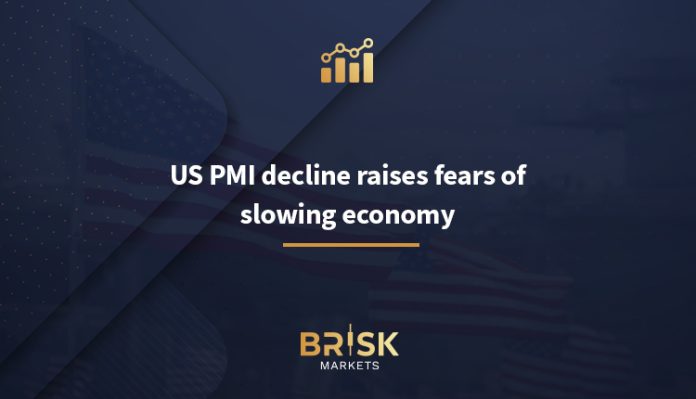
The US manufacturing PMI fell from 51.9 to 49.9 in April. The services PMI fell from 51.7 to 50.9. The composite PMI fell from 52.1 to 50.9.
The economic improvement in the US lost momentum at the start of the second quarter, with respondents to the PMI Quick Survey reporting below-trend growth in business activity in April. Further pace could be lost in the coming months, as April saw new business flows fall for the first time in six months and future production expectations for companies fall to a five-month low amid growing concerns about the outlook.
The more challenging business environment has pushed companies to cut salary numbers at a rate not seen since the global financial crisis if months of early pandemic lockdowns are ruled out.
Deteriorating demand and a slowdown in the labor market have reduced price pressures, with April seeing a welcome decline in the rates of increase in selling prices for both goods and services.
It is noteworthy that the drivers of inflation have changed. The manufacturing sector has now recorded a sharp rate of price increases in three of the past four months, with plant cost pressures intensifying in April amid higher raw material and fuel prices, in contrast to price pressures associated with wage-related services seen throughout much of 2023..
Enhanced interest in the euro emerged after preliminary estimates of the Purchasing Managers’ Index (PMI) showed a surprise acceleration in the services sector.
France (46.2 to 44.9) and Germany (41.9 to 42.2) both saw their manufacturing PMIs fall below expectations (46.9 and 42.8, respectively). This reinforces idea that eurozone industry, which has been in a contraction zone since June 2022, has seen a sharp decline since beginning of the year. These data may bring the European Central Bank’s interest rate reduction cycle closer.
US PMI decline worries markets and supports gold andS&P500
On April 23, 2024 , S&P Global released its US PMI reports for April. The manufacturing PMI was reported to have fallen from 51.9 in March to 49.9 in April, compared to analysts’ consensus of 52. The figures show below 50 contractions .
The services PMI fell from 51.7 to 50.9, compared to analysts’ expectations of 52. The composite PMI fell from 52.1 to 50.9, defying expectations .
S&P Global commented: “Further pace may be lost in the coming months, with April seeing new business flows fall for the first time in six months and the outlook for businesses fall to a five-month low amid growing concern about the outlook .”
The report highlighted inflation problems. S&P Global noted that manufacturing recorded sharp rate of price increases in three of the past four months. More importantly, plant cost pressures intensified in April .
The US dollar index tested session lows after the release of weaker-than-expected PMI reports. Traders are betting that a potential slowdown in the economy would force the Fed to be more pessimistic .
Gold has rebounded from session lows and is trying to settle above the $2330 level . A weaker dollar and lower Treasury yields have provided support to gold markets .
The SP500 is trying to settle above the 5050 level as traders react to the Purchasing Managers’ Index (PMI) data . The reports may provide additional support to the stock markets as the Fed’s policy outlook acts as an important catalyst for equities .
Dollar indices fall strengthens Swiss franc after weak US PMI data
The USD/CHF pair faces a sell-off above the full support level at 0.9100 in the early US session on Tuesday. The Swiss franc’s asset fell with the US Dollar Index (DXY) falling to 105.80 after S&P Global reported weak preliminary PMI data for April.
Both the manufacturing PMI and services missed expectations. The manufacturing PMI slides below the 50.0 threshold that separates expansion from contraction. Factory data fell at 49.9 below expectations of 52.0 and the previous reading of 51.9. The services PMI fell to 50.9 from the consensus of 52.0 and the previous reading of 51.7.
Going forward, investors will shift their focus to the US Core Personal Consumption Expenditure (PCE) price index data for March, which will be published on Friday.
The core PCE price index data is the Fed’s preferred inflation measure. It is estimated to grow steadily by 0.3% month-on-month, with annual inflation eased to 2.6% from 2.8% recorded in February. This will affect market expectations on interest rate cuts by the Fed, which are currently expected to be made at the September meeting .
US 10-year Treasury yields rose to 4.64% as the Fed continues to argue that the current monetary policy framework is appropriate as stubbornly high inflation in the first quarter of this year cannot be ignored .
The formation of the USD/CHF pair on the four-hour timeframe appears to be a bullish wedge chart pattern, indicating a limited uptrend The 14-period RSI moves to the range of 40.00-60.00, indicating future consolidation.















